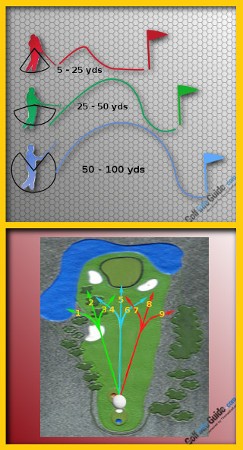Technique Using Golf Ball Flight to Vary Distance

If you only have one ‘stock’ ball flight which you use for all of your approach shots, your development as a golfer will be limited. It might seem intimidating to develop other shots for use on the course, but the process of doing so can help to greatly expand your skills as a golfer. Also, if you are able to learn how to hit some new shots, you can effectively cover more yardages than you could previously – even without adding any new clubs to your bag.
Let’s walk through an example to highlight how this process can work. Imagine for a moment that you are a player who tends to fade the ball from left to right on approach shots. Your fade is reliable, and the ball curves in the expected direction almost every time. When hitting a seven iron with your slight fade, the ball tends to fly about 150 yards in the air.
Now, picture a hole where you have 155 yards to the target. The hole is located in the front section of the green, and there is a bunker guarding the front of the green as well. What are you going to do? If you use your seven iron with a typical fade, it is going to be nearly impossible to carry the ball all the way to the hole. You’ll have to hit an absolutely perfect shot, and even then, you might wind up short. Of course, with that bunker waiting short of the green, you don’t want to miss in that spot.
So, should you go down to the six iron? That certainly is an option, but it has its drawbacks as well. Specifically, you are likely to play the ball well long of the cup when you use the six iron, since you can’t risk taking it in low and having it catch the bunker. This would be the safe play, and there is nothing wrong with it, but you shouldn’t expect to make a birdie this way.
If you would like to give yourself the best possible chance at a birdie, the choice is easy – use the seven iron and turn it over from right to left. Hitting a draw is likely to add a few yards to the distance of your shot, and a few extra yards is exactly what you need in this situation. If you’ve taken the time to learn how to hit a draw on the range, you can take advantage of that preparation and use the shot which is ideal for the circumstances.
You don’t want to have to go away from your stock ball flight too often, but doing so when the situation is right will help you save strokes. Also, knowing how to manipulate the flight of the ball will pay off in other circumstances, such as when you need to get around an obstacle like a tree that may be in your way. Amateur golfers tend to think of using a variety of ball flights as an advanced skill, and it is, but it is one which you should work on learning anyway. In the process, your ‘regular’ swing is likely to improve, and you’ll be a better player in the long run.






